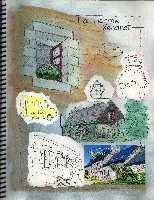 La Côte de Granite Rose,
La Côte de Granite Rose,
Coast of France. (#0995)
 La Côte deGranite Rose
La Côte deGranite Rose
drawn on croissant bags. (#S-0013)
 Our home, La Ferme Keraret ,
Our home, La Ferme Keraret ,
Brittany France. (#S-0008)
Click on any of the Brittany images
to see Dianne's Photo Album |
Sketching In Brittany
1564 words
How To Use A Sketchbook To Record Your Travels
by Dianne Roth
If ever you have wanted to learn how to keep a travel sketchbook, you could just do it, or you could slip into it under the gentle guidance of Mari le Glatin Keis. Her 10-day workshops are designed around a tour that gives even the beginner the experience of recording travel impressions with whatever medium is at hand.
In June, she met our group at the Guingamp Train Station in Brittany. She had recruited drivers to take us to the Ferme Keraret near the village of Plougrescant along the northern coast of France. We divided up among the cars and enjoyed a beautiful drive through old villages, tidal estuaries, and artichoke fields.
Being an “old timer” on these sketching workshops, I knew I could trust Mari to find just the right setting for my pen and paper. I was not disappointed. We unpacked in a 300 year old stone farmstead and began our adventure.
The participants on this workshop were a mix of old friends (former participants) and new, artists and first-timers. All were hungry, both for food and inspiration. Mari first filled our bellies with a delicious traditional meal of galette, a buckwheat crepe filled with ham, eggs, and cheese, washed down with cider. Then, she opened up the world of sketching to fill our souls.
“It is simple,” she stated, “You do not learn how to sketch, you sketch.” It is a sentence I have heard four times and still it is fresh and inspiring. Her philosophy is simple, and elegant. Do it and you will be doing it. With a simple demonstration of contour drawing (drawing the shape of something that does not move without looking at your sketchbook) and gesture drawing (drawing the movement of something without looking at your sketchbook), she turned us loose to explore the farm and the village.
Brittany is a very different experience from my participation in le Glatin Keis’ workshop in Provence in southern France. Here, the colors are more subtle, the weather more moderate, and the people less... well, ...less French. In fact, the culture of Brittany is not French at all. The heritage of the Bretons is Celtic. The language, the food, the fishing, the entire cultural identity has an Irish and Welsh flavor that can be seen everywhere.
Walking along the road with my pocket sketchbook and my favorite pen, my companion and I found a trail down to the tidal flats. Squeezing between stinging nettles and blackberries, I was reminded of our own estuaries along the Coast of Oregon. The tide was out and we split up to find bits of the scene to capture on paper. My sketches show a working landscape: fishing boats coming and going, oyster beds being tended, fields of green and gold, people fishing from the dock in the harbor. Apparently, most of our travel companions on the train were still heading for Brest on the far tip of the peninsula. Not much suggested that tourists have found this little, out of the way hamlet.
The “beach” is a bed of orange and grapefruit sized granite rocks that made keeping my eye on my footing essential. But, having to keep such a steady eye on my steps brought me close to the small world at my feet. I used my contour and gesture skills to sketch kelp in a dozen shapes and colors, shells of oysters, mussels, limpets, and rocks in shades of pink, green, yellow, and blue-black.
Pulling my eyes toward the distance I found boats and barges, big-wheeled tractors driving through the water, a heron and sea gulls, and buoys of every shape and color to mark the the gigantic boulders that make the channel treacherous at high tide. It was all framed by fields, hedgerows, and a sky the color of new metal that has been burnished with texture and a color promising rain.
Picking my way along the exposed river bed, I came to the ancient harbor of La Roche Jaune. It was filled with small rubber rafts, a sight I thought funny until I found out that they marked the moorage of boats that were out at sea. I closed my eyes and imagined centuries of women and children waving at the departing fleet and the slow pace of life that can be traced back in time. Behind me was Cafe Pesked where traditional “moules et frites” (mussels and fries) were advertised in the window.
By 7:00, I was back at the farm in time for aperitif and formal introductions to our hosts, Elizabeth and Yves, who would be caring for us during our 10 day stay.
Our first excursion was to l’Ile d’ Er (the Isle of Er). Mari encouraged us to travel light. “Your small sketchbook and your pen is all you will need... and your lunch.” We ate in the picturesque boat graveyard and waited for the tide to recede to a safe point for walking. This estuary is second only to the Bay of Fundy in tidal surge. We would be walking across the channel filled with islands and boulders as far as we could see. We had a small window of safety to get to the island and return before it became too deep and too strong to hazard the return crossing. We straggled through tidal rivulets taking time to sketch the sea life at our feet and the panorama before our eyes.
Later in the evening, I walked to a vista point near the farm and was stunned to see that it was all gone. L’Ile d’ Er was still there but surrounded by the smooth sea. Rocks and islands were hidden until the next low tide.
Elizabeth’s breakfasts were hearty and delicious, fortifying us for our daily adventures, and Mari’s reminders were gentle and inspiring. “Paint with your eyes and let your hand follow.
On the second day of the workshop, we were shuttled to La Côte de Granite Rose (the Coast of Pink Granite). Walking a short way with a companion, we found a place to eat our lunch and enjoy friendly seagulls. Gigantic pink boulders that seemed alive with personalities and emotions surrounded us. Le Glatin Keis calls them the Stone People and I could understand why. Faced with this magnificence, my sketches became more and more abstract. There was more than just color and shape that I wanted to capture, I wanted the spirit, the soul of the rocks to come alive on my page. My efforts recall it all. I feel the sun’s heat, the smell of open sea, the squawk of fussy seagulls. And, among the sights, smells, and sounds on my page, I am touched by the ancient life of the Stone People.
Another day we visited Le Château de la Roche Jagu. This was no ruined castle. From its great room to the storage under the eaves, the castle was wide open to visitors. The massive circular stone staircase and structural beams offered opportunities to record texture and color while leading from room to room, landing to landing.
On the second floor of the castle, we discovered an exhibit of sketches by Louis-Marie Faudacq (1840-1916). During the 1800’s, he was a customs agent walking the coast of France looking for smugglers. His log book was full of quick, expressive sketches of life along the coastal waterways of Brittany. His simple lines and spare use of color suggest sails full of wind, the backbreaking motion of washing clothes, and the ever-changing moods of sea and sky. I copied many of his scenes into my sketchbook. I still had so much to learn!
Some mornings we stayed at the farmhouse and used the time as a workshop. The breakfast dishes were cleared away and replaced with collage materials. Newspapers, maps, postcards, stamps, placemats, bottle labels, leaves, and grasses were tossed out for community use. Mari used a beautiful photograph from the newspaper to begin her collage demonstration. With a quick movement she tore the photo in half, stunning her audience. Once glued, the pieces became the foundation for watercolor, pastel, and sketches from her pocket sketchbook. In just a few minutes she had recorded her impressions of a moment in time. “It is not the aesthetic,” she reminded. “It is your emotion in the experience.”
In my sketchbook, the 11th century ruins of le Château de Tonquédec were sketched onto a newspaper photo of Mars. Small granite stones, found on l’Ile de Bréhat turned the illustrated bags from my morning croissants into magnificent boulders. And, a study of a yellow-clad fisherman was mounted on grey paper that matched the sky and was highlighted with a wash from my evening wine glass.
The cherries, the steeples, hay baled into rolls, and even the cow that looks like a pig are the sensory reminders of days filled with nature, laughter, silence, and sketching. As I open these pages, I am transported to the panorama of Brittany, my mind filled with sea winds, bird songs, warm rain, slate roofs, good cheese, tangy cider, artichokes, and wonderful people. I look in my sketchbook and know that everyday was a great day!
“The Art of Travel with a Sketchbook” is a workshop led by Corvallis artist Mari Le Glatin Keis. She offers workshops in Mexico, Spain, France, Costa Rica, and the Pacific Northwest starting in February, 2006. Visit her website at www.artraveljournals.com.
Dianne Roth is a teacher, mother, grandmother, and freelance
writer. She lives in Oregon.
|
|
